59TH ANNUAL CONFERENCE, Singapore, 30 March – 3 April 2020WP No. 88Radio Mandatory Zones / Transponder Mandatory ZonesPresented by TOC |
| IMPORTANT NOTE: The IFATCA Annual Conference 2020 in Singapore was cancelled. The present working paper was never discussed at Conference by the committee(s). Resolutions presented by this working paper (if any) were never voted. |
Summary
The air traffic density is constantly increasing and due to specific airspace classification, controlled IFR traffic can be mixed up with uncontrolled VFR traffic. With the intention to improve safety, additional SSR transponder and radio equipment carriage requirements have been implemented.
This working paper explains the concept of a Transponder Mandatory Zone (TMZ) / Radio Mandatory Zone (RMZ), elaborates on the possible benefits and disadvantages of its realization and describes what needs to be considered to implement a TMZ/RMZ.
Introduction
1.1 With the intention to improve safety, additional SSR transponder and radio equipment carriage requirements have been implemented in several states.
1.2 Within well-known Airspace Classification new terms have been developed, Radio Mandatory Zones and Transponder Mandatory Zones, and became officially defined by European Union Regulation EU No 923/2012 of September 2012 as part of Standardized European Rules of Air (SERA). It was issued after the European Commission mandated Eurocontrol and EASA to harmonise the regulations between states.
1.3 IFATCA TOC already provided a Transponder Mandatory Zones study working paper in 2012 Kathmandu, Nepal Annual Conference. The current working paper aims to amend information regarding developments of TMZ, introducing RMZ, discuss their benefits and disadvantages on the legal and operational levels.
Discussion
2.1.1 While ICAO still has no standard definition of a Transponder Mandatory Zone or a Radio Mandatory Zone, Standardized European Rules of Air (SERA) were issued after the European Commission mandated Eurocontrol and EASA to harmonise the regulations between EU states. Initial European Union Regulation EU No 923/2012 became applicable (in EU) in December 2012 and was amended by EU Regulation 2016/1185 which became applicable (in EU) December 2017.
2.1.2 Transponder Mandatory Zone and Radio Mandatory Zone have the following definition in SERA:
‘transponder mandatory zone (TMZ)’ means an airspace of defined dimensions wherein the carriage and operation of pressure-altitude reporting transponders is mandatory;
‘radio mandatory zone (RMZ)’ means an airspace of defined dimensions wherein the carriage and operation of radio equipment is mandatory;
2.2 Need and purpose of TMZ
2.2.1 ICAO requires only internationally operating commercial airplanes and helicopters to be equipped with –
a) SSR transponders:
ICAO Annex 6, Operation of Aircraft, Part I, International Commercial Air Transport, Aeroplanes
6.20.1 All aeroplanes shall be equipped with a pressure-altitude reporting transponder which operates in accordance with the relevant provisions of Annex 10, Volume IV.
ICAO Annex 6, Operation of Aircraft, Part I, International Operations, Helicopters
4.13 Except as may be otherwise authorized by the appropriate authority, all helicopters shall be equipped with a pressure-altitude reporting transponder which operates in accordance with the provisions of Annex 10, Volume IV.
b) large airplanes to be equipped with ACAS:
ICAO Annex 6, Operation of Aircraft, Part I, International Commercial Air Transport, Aeroplanes
6.19.1 All turbine-engined aeroplanes of a maximum certificated take-off mass in excess of 5 700 kg or authorized to carry more than 19 passengers shall be equipped with an airborne collision avoidance system (ACAS II).
Air traffic density is constantly increasing and due to specific airspace classification, controlled IFR traffic can be mixed up with uncontrolled VFR traffic. A large number of General Aviation (GA) aircraft are not equipped with SSR transponders. Furthermore, GA pilots flying under VFR sometimes infringe restricted controlled airspace. Aircraft equipped with Airborne Collision Avoidance System (ACAS) and receiving air traffic control services will not be able to detect VFR traffic without an operating transponder.
2.2.2 To increase ACAS effectiveness and minimize the risk of a mid-air collision between unknown/uncontrolled VFR traffic and controlled commercial air transport and military jet traffic, several States have taken measures to expand the mandatory use of transponders. Some States even have requirements for SSR Mode-S transponders.
2.2.3 In a TMZ, an operational pressure-altitude reporting transponder is mandatory for all aircraft that wish to enter or to fly within the defined area. The airspace classification of the area is not changed by the introduction of a TMZ, and the pilot’s responsibility to “see and avoid” during a flight remains unchanged.
2.2.4 In some States, the GA pilot’s community is so huge that changing the airspace classification could become a political issue. State authorities are avoiding the whole airspace reclassification, trying not to disturb these large GA communities. Hence, the TMZ/RMZ idea allows to shift the responsibility of the design and setup of these airspaces from governmental bodies to ANSP managers, while airspace classes are officially “unchanged”. In such States, the creation of TMZs could be a work-around solution in order not to go through the airspace upgrading process.
2.3 Need and Purpose of RMZ
2.3.1 To allow GA pilots without transponders to fly within “conflicting” uncontrolled airspace and minimize collision risks between unknown/uncontrolled VFR traffic and controlled commercial air transport or with military jet traffic, Radio Mandatory Zones (RMZ) were introduced.
2.3.2 To increase ATCO/FISO situational awareness RMZ and TMZ combined provide the most enhance aircraft conspicuity to ATS unit within dedicated airspace.
2.4 TMZ/RMZ Global Use Examples
2.4.1 Current studies show that TMZ/RMZs are not only implemented in Europe. Under different names, States have published NOTAMs or AIP amendments with similar use of dedicated airspace. For example, Hong Kong uses the term “Uncontrolled Aircraft Reporting Area” for the same purposes as RMZ.
2.4.2 TMZs have been implemented in the vicinity of London Stansted, as the result of an overriding safety concern in relation to the number and severity of airspace infringements.
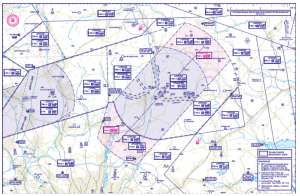
Figure 1. UK Stansted TMZs
2.4.3 The UK considers implementing TMZs to enable several wind farms in the Greater Welsh area of the southern North Sea. It is expected that these wind farms will produce primary clutter on the ATC radar system. This clutter could obscure primary returns from aircraft and could interfere with radar tracking resulting in erroneous radar data. This would reduce the ability to observe primary-only aircraft and increase the risk of not detecting conflicts, which would be prevented by implementing a TMZ.
2.4.4 The implementation of TMZs in The Netherlands was a result of a couple of near-misses between military jet traffic and general aviation.
2.4.5 In Germany the number of IFR movements at an airport determines which airspace classification is chosen and if a TMZ is designated for that specific airport. The choice of designation of airspace classification and/or the creation of a TMZ is based on the final decision of the German Ministry of Transport, after being provided with suggestions from the ANSP and other aviation stakeholders (e.g. airlines, pilot associations, general aviation representative bodies and associations, etc.). These stakeholders meet together at least once a year. German ANSPs currently refrain from establishing RMZs due to the fact that an initial call has to be made by all aircraft, which could lead to frequency congestion, preferring only establish TMZs, but requiring aircraft to be on a dedicated frequency.
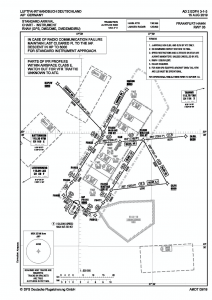
Figure 2. EDFH – Frankfurt Hahn now has lot of TMZs published in the AIP
2.4.6 There are many areas in Canada where the airspace is Class D, but with mandatory transponder use (TMZ). Also, many Class E airspace zones come with mandatory frequency monitoring (RMZ).
2.5 TMZ/RMZ Requirements and Procedures
2.5.1 EU SERA states:
Requirements for communications and SSR transponder [REF SERA.6005]
(a) Radio mandatory zone (RMZ)
(1) VFR flights operating in parts of Classes E, F or G airspace and IFR flights operating in parts of Classes F or G airspace designated as a radio mandatory zone (RMZ) by the competent authority shall maintain continuous air- ground voice communication watch and establish two-way communication, as necessary, on the appropriate communication channel, unless in compliance with alternative provisions prescribed for that particular airspace by the ANSP .
(2) Before entering a radio mandatory zone, an initial call containing the designation of the station being called, call sign, type of aircraft, position, level, the intentions of the flight and other information as prescribed by the competent authority, shall be made by pilots on the appropriate communication channel.
(b) Transponder mandatory zone (TMZ)
(1) All flights operating in airspace designated by the competent authority as a transponder mandatory zone (TMZ) shall carry and operate SSR transponders capable of operating on Modes A and C or on Mode S, unless in compliance with alternative provisions prescribed for that particular airspace by the ANSP.
(c) as radio mandatory zone and/or transponder mandatory zone shall be duly promulgated in the aeronautical information publications.
2.5.2 Many new European standard procedures regarding the use of SSR transponders were published with the new amendments to SERA and entered into force in 2017:
SERA.13001 Operation of an SSR transponder
(a) When an aircraft carries a serviceable SSR transponder, the pilot shall operate the transponder at all times during flight, regardless of whether the aircraft is within or outside airspace where SSR is used for ATS purposes.
(b) Pilots shall not operate the IDENT feature unless requested by ATS.
(c) Except for flight in airspace designated by the competent authority for mandatory operation of transponder, aircraft without sufficient electrical power supply are exempted from the requirement to operate the transponder at all times.
SERA.13010 Pressure-altitude-derived information
(a) When the aircraft carries serviceable Mode C equipment, the pilot shall continuously operate this mode unless otherwise dictated by ATC.
(b) Unless otherwise prescribed by the competent authority, verification of the pressure- altitude-derived level information displayed to the controller shall be effected at least once by each suitably equipped ATC unit on initial contact with the aircraft concerned or, if this is not feasible, as soon as possible thereafter.
SERA.13020 SSR transponder failure when the carriage of a functioning transponder is mandatory
(a) In case of a transponder failure after departure, ATC units shall attempt to provide for continuation of the flight to the destination aerodrome in accordance with the flight plan. Pilots may, however, be expected to comply with specific restrictions.
(b) In the case of a transponder which has failed and cannot be restored before departure, pilots shall:
(1) inform ATS as soon as possible, preferably before submission of a flight plan;
(2) insert in Item 10 of the ICAO flight plan form under SSR the character ‘N’ for complete unserviceability of the transponder or, in case of partial transponder failure, insert the character corresponding to the remaining transponder capability; and
(3) comply with any published procedures for requesting an exemption from the requirements to carry a functioning SSR transponder.
New SERA amendments mandate pilots to use transponder (if available) at all times in flight, not only in TMZs.
For some States, TMZs became even more strict, denying entry to aircraft in TMZs, if there is no transponder onboard. Pilots concerned need to avoid these zones, causing an increasing amount of complains and lack of consensus for new TMZ/RMZ implementations from the GA community. Their argument is mainly the limitation of their right to fly within uncontrolled airspace; but it meets a counter-argument from ANSP/CAA, that they have to retrofit their aircraft with SSR transponders to maintain an adequate level of safety for themselves as well as for others.
2.5.3 ICAO Annex 11 states:
ICAO. Annex 11. ATS. Chapter 2.27 Establishment of requirements for carriage and operation of pressure-altitude reporting transponders.
States shall establish requirements for carriage and operation of pressure-altitude reporting transponders within defined portions of airspace.
Note.— This provision is intended to improve the effectiveness of air traffic services as well as airborne collision avoidance systems.
According to this ICAO requirement, EU SERA TMZ and SSR requirements are fully compliant with ICAO.
2.6 TMZ/RMZ Different Setups
2.6.1 The EU definition for RMZ and TMZ, apart from standard requirements, includes possibilities for “alternative provisions prescribed for that particular airspace by the ANSP”. This leads to significant differences between operational TMZ/RMZ configurations across States. Here are some examples of these setups.
RMZs Only:
- RMZ information only (not strict). Flights, prior to entering the RMZ, call the ATS unit on the appropriate frequency, informing their flight details. They enter the RMZ without additional permission.
- RMZ information only, but may be required to remain outside (semi strict). Aircraft, before entering RMZ call the ATS unit on the appropriate frequency with the intention to pass details prior to entering the RMZ. If asked to standby (or any other instructions to wait) by ATS unit, they shall remain outside the RMZ. Only after the ATS unit asked to pass flight details, flights may enter the RMZ.
- RMZ subject to permission (strict). Aircraft, before entering RMZ, call on the appropriate frequency, informing their flight details, but stay outside the RMZ unless permitted by the ATS unit.
TMZs Only:
- TMZ – not strict. All aircraft should have operating SSR (A+C) or Mode S transponder to enter the TMZ without any communication. Aircraft without transponder still can enter the TMZ, but after approval from the appropriate ATS unit on the appropriate frequency.
- TMZ – strict. All aircraft shall have operating SSR (A+C) or Mode S transponder to enter the TMZ without any communication. Aircraft without transponder cannot enter TMZ.
RMZ/TMZ Combinations:
- RMZ + TMZ. Any combination of the above, RMZ and TMZ, requiring all aircraft to maintain an operating transponder as well as establish 2-way communications with the ATS unit before entering the zone.
- TMZ + Listening Watch. In busy areas, to avoid possible frequency congestion by RMZs (where initial call shall be made by all aircraft), ANSPs came up with a combination of TMZ with a designated radio frequency listening watch. In strict setups, listening watch is mandatory, but in less strict setups frequency listening watch can be voluntary.
2.6.2 Such a difference of airspace configurations under the same TMZ or RMZ definitions can be confusing for pilots, as ANSPs are not limited to their own and unique ideas of TMZ/RMZ implementation. The possibility of a lack of airspace harmonisation is evident, even more so with neighbouring countries.
2.6.3 UK RMZ/TMZ procedure example:
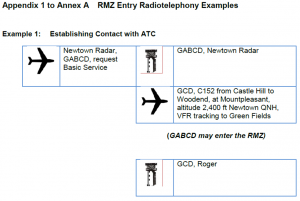
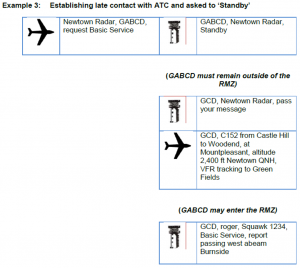
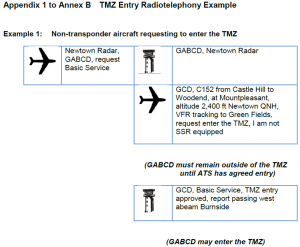
2.7 TMZ/RMZ Controversial Benefits
2.7.1 Equipage of GA aircraft with transponders and/or ACAS when operating within uncontrolled airspace is currently voluntary in most States. Mandating all traffic in TMZs to operate with a transponder increases effectiveness of Airborne Collision Avoidance Systems (ACAS/TCAS). By improving the efficiency of ACAS, TMZs increase safety by reducing the risk of a mid-air collision.
2.7.2 TMZs/RMZs enhance aircraft conspicuity to ATS units, increasing the situational awareness of ATCOs/FISOs.
2.7.3 TMZs/RMZs are, for ANSPs, an inexpensive, easy and flexible solution to increase situational awareness (for commercial pilots and ATCOs) in dedicated portions of uncontrolled airspace. Despite the increasing demand from GA pilots to fly in these zones, this solution will still allow them to operate under published procedures, but without changing the airspace classification, which sometimes can be cumbersome, expensive, and lengthy.
2.8 TMZ/RMZ Disadvantages
2.8.1 The effectiveness of TMZs depend on the correct functioning of the transponder (both Mode A and Mode C) and the effectiveness of RMZs is heavily dependent on the correct functioning of the on-board radio – both systems are not systematically checked before entering these zones – so these two solutions cannot offer the same level of safety compared to ATS provision (where it is ascertained that the equipment is working properly or alternate safety measures/procedures are carried out).
2.8.2 Mandating the use of operational transponders in high-density traffic areas could result in radar clutter and overlapping of radar labels. This problem could be avoided locally by a technical workaround to the system, “filtering” the targets on the ATC screen.
2.8.3 The huge amount of SSR data, due to TMZs in high-density traffic areas, has resulted for some ANSPs in an overloaded ATS system. This overload of the system resulted in the loss of radar labels without any warning for controllers working live traffic.
2.8.4 The overload of an ATS system could imply that the system is outdated and needs to be upgraded or renewed. Bringing the ATS system up to an acceptable level will normally require a considerable amount of time and investment. Depending on the urgency of the situation, especially when safety is involved, the appropriate authorities should take effective measures by (temporarily) changing the airspace classification or implementing a TMZ.
2.8.5 Implementation of an RMZ close to controlled sector boundaries will require GA pilots to perform rapid and frequent changes of radio frequencies, thus increasing their workload. With only one radio on board, this may be difficult.
2.8.6 RMZs established in high-density traffic area could overload radio frequency with potentially a resulting less-safe state and other potential risks.
2.8.7 It could take a long time to get consensus on TMZs/RMZs with all stakeholders involved (ANSP(s), CAA, GA pilots).
2.8.8 There is also a potential for confusion amongst GA pilots, with more and more airspace configurations across States.
2.9 TMZ/RMZ Considerations
2.9.1 Before a TMZ or airspace classification change is implemented, an impact assessment as part of a safety case should be conducted to ensure that all aspects are addressed.
2.9.2 Mandating the use of operational transponders in high-density traffic areas could result in radar clutter and overlapping of radar labels. This problem could be avoided by a local technical workaround in the system, “filtering” the ATC screen. Some ANSPs have installed technical filters in their ATS surveillance systems to filter specific altitudes, which prevents an overload and/or overlapping of undesired radar labels.
2.9.3 The combination of mandating SSR transponders and the implementation of a technical filter in ATS surveillance displays could provide a solution to previously mentioned issues with TMZs. This solution does not restrict or limit general aviation in an undesired way, but ensures that potentially conflicting VFR traffic carry an operational SSR transponder to enable ACAS systems to perform as a safety net.
2.9.4 Especially in the vicinity of IFR arrival and departure routes, it is essential for the proper operation of ACAS that all traffic carry an operational SSR transponder. Due to the nature of the airspace, uncontrolled general aviation often operates just below or in the vicinity of these routes. As long as this uncontrolled general aviation remains well separated from IFR routes, ATCOs do not want this traffic to cause radar clutter and overlapping of labels, and filtering out radar labels of this uncontrolled general aviation does not compromise safety.
2.9.5 Nevertheless, uncontrolled traffic infringing restricted controlled airspace must be detectable for ACAS and ATC. A technical filter could ensure that pilots remain able to detect uncontrolled traffic in their vicinity without causing radar clutter to ATC screens, especially when all traffic is mandated to carry an operational SSR transponder.
2.9.6 Some ANSPs have already installed a technical filter, which filters out specific (VFR) targets. However, in some of these systems, the Short-Term Conflict Alert (STCA) feature can override the filter when it detects a conflict. A disadvantage of this application is that it also reacts to incorrect mode C signals, which implies that mode C should always be verified as part of an aircraft operational checklist and also be verified by the first ATS unit.
2.10 IFATCA Policies Review
2.10.1 IFATCA policy is:
| TPM ATS 3.34 TRANSPONDER MANDATORY ZONES
All aircraft operating as IFR flights shall be equipped with a pressure-altitude reporting transponder. (Resolution B5 – WP 90 – Kathmandu 2012) |
Current IFATCA policy is considered valid, but seems to be very broad, and not fully relevant with the current TMZ idea. The policy covers only IFR traffic, but most of TMZs are established for VFR flights within class E/F/G airspace.
2.10.2 IFATCA policy is:
| TPM AAS 1.3 MODE S DEVELOPMENT
ATC surveillance systems must be able to process all data, regardless of the volume or type, necessary to provide ATC Services safely. (Resolution B5 – WP 90 – Kathmandu 2012) |
This policy is considered relevant as RMZ/TMZ can cause an overload not only on the screen but also in system data. The system needs to be able to process everything.
2.10.3 IFATCA policy is:
| TPM ATS 3.3 HARMONISATION OF THE AIRSPACE CLASSIFICATION
MA’s shall urge ATS Authorities to co-ordinate and harmonise with all neighbouring states their national airspace classification, in accordance with ICAO Annex 11 Appendix 4, to permit safe and efficient operating conditions to all airspace users and air traffic controllers. Airspace classification should be appropriate for the traffic operating in the airspace, to avoid over and under classification. As traffic situations change, the classification may have to change accordingly. Local operational controllers should be involved in the airspace classification process. (Resolution of WP 310 – Las Vegas 2016) |
This policy is considered relevant; as mentioned above, different TMZ/RMZ setups and their combination with listening watch make the airspace structure more and more complicated and procedures difficult to follow. This is covered by the policy under “avoiding over classification”. With a total of seven internationally accepted classes of airspace (from A to G), there are a lot of possibilities. Starting from the 1990’s these classes were successfully established around the globe and their effectiveness was verified, so there is no need to add more confusion by adding additional classes. IFATCA TOC is of the opinion that TMZs/RMZs should not be a work around to avoid a proper airspace upgrading process and should be of temporary nature.
2.10.4 IFATCA Policy is:
| TPM WC 8.2.8 REGULATORY APPROVAL OF ATM SYSTEMS EQUIPMENT
MAs should encourage their State’s Regulatory Authority to play a role in the development and certification / commissioning and oversight during the life cycle of air traffic control equipment. Any information displayed at a controller working position shall be approved to be used operationally. (Resolution B5 – WP 92 – Conchal 2019) |
This policy is considered relevant as mandating the use of operational transponders in high- density traffic areas could result in radar clutter and overlapping of radar labels on controller working positions, keeping in mind that most of these tracks will not be useful to controllers most of the time.
Conclusions
3.1. ICAO has no “radio mandatory zone (RMZ)”, nor “transponder mandatory zone (TMZ)” definitions.
3.2. TMZ/RMZ have been established not only in Europe, but globally.
3.3. TMZ/RMZ requirements may prove to be restrictive for GA traffic, as compliance with procedures may be difficult.
3.4. TMZ/RMZ shall not be a work-around for a modification to the airspace class.
3.5. TMZs in busy areas may overload ATC systems and CWP displays.
3.6. RMZs in busy areas may overload frequency(ies).
3.7. General Aviation aircraft transponders and communication systems are not systematically checked before entering TMZ/RMZ, so these two zones cannot offer the same level of safety compared to ATS.
Recommendations
It is recommended that:
4.1 IFATCA Policy is:
Implementation of a RMZ/TMZ should not be used as an alternative for adequate airspace classification or design.
When a RMZ/TMZ is implemented:
- Clear procedures and appropriate training should be in place;
- Due care should be given to surveillance and communication system capabilities.
and is added to the IFATCA Technical and Professional Manual.
References
Study Transponder Mandatory Zones, IFATCA WP No.90, 51st Annual Conference, Kathmandu, Nepal, March 12 – 16, 2012.
Definitions, Article 2, European Union Regulation EU No 923/2012, 23 September 2012, Official Journal of the European Union.
Requirements for Pressure-Altitude Reporting Transponders, Chapter 6, Aeroplane instruments, equipment and flight documents, ICAO Annex 6, Operation of Aircraft, Part I, International Commercial Air Transport, Aeroplanes, Eleventh Edition, July 2018.
Helicopter Instruments, Equipment and Flight Documents, Chapter 4. , ICAO Annex 6, Operation of Aircraft, Part III, International Operations, Helicopters, Ninth Edition, July 2018.
Establishment of requirements for carriage and operation of pressure-altitude reporting transponders, Chapter 2.27, ICAO Annex 11, ATS, Fifteenth Edition, July 2018.
Separation in Class E Airspace, IFATCA WP No.310, 55th Annual Conference, Las Vegas, USA, March 14-18, 2016.
Operational use of DAPs (Down-link Aircraft Parameters), IFATCA WP No.92, 58th Annual Conference, Conchal, Costa Rica, 20-24 May, 2019.
Last Update: October 2, 2020
